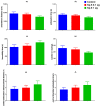Kisspeptin-8 Induces Anxiety-Like Behavior and Hypolocomotion by Activating the HPA Axis and Increasing GABA Release in the Nucleus Accumbens in Rats
- PMID: 33503835
- PMCID: PMC7911394
- DOI: 10.3390/biomedicines9020112
Kisspeptin-8 Induces Anxiety-Like Behavior and Hypolocomotion by Activating the HPA Axis and Increasing GABA Release in the Nucleus Accumbens in Rats
Abstract
Kisspeptins (Kp) are RF-amide neuropeptide regulators of the reproductive axis that also influence anxiety, locomotion, and metabolism. We aimed to investigate the effects of intracerebroventricular Kp-8 (an N-terminally truncated octapeptide) treatment in Wistar rats. Elevated plus maze (EPM), computerized open field (OF), and marble burying (MB) tests were performed for the assessment of behavior. Serum LH and corticosterone levels were determined to assess kisspeptin1 receptor (Kiss1r) activation and hypothalamic-pituitary-adrenal axis (HPA) stimulation, respectively. GABA release from the nucleus accumbens (NAc) and dopamine release from the ventral tegmental area (VTA) and NAc were measured via ex vivo superfusion. Kp-8 decreased open arm time and entries in EPM, and also raised corticosterone concentration, pointing to an anxiogenic effect. Moreover, the decrease in arm entries in EPM, the delayed increase in immobility accompanied by reduced ambulatory activity in OF, and the reduction in interactions with marbles show that Kp-8 suppressed exploratory and spontaneous locomotion. The increase in GABA release from the NAc might be in the background of hypolocomotion by inhibiting the VTA-NAc dopaminergic circuitry. As Kp-8 raised LH concentration, it could activate Kiss1r and stimulate the reproductive axis. As Kiss1r is associated with hyperlocomotion, it is more likely that neuropeptide FF receptor activation is involved in the suppression of locomotor activity.
Keywords: HPA axis; HPG axis; Kiss1 receptor; anxiety; kisspeptin; locomotion; nucleus accumbens.
Conflict of interest statement
The authors declare no conflict of interest.
Figures













Similar articles
-
Effects of kisspeptin-13 on the hypothalamic-pituitary-adrenal axis, thermoregulation, anxiety and locomotor activity in rats.Behav Brain Res. 2013 Mar 15;241:56-61. doi: 10.1016/j.bbr.2012.11.039. Epub 2012 Dec 3. Behav Brain Res. 2013. PMID: 23219969
-
Kisspeptin Stimulation of Prolactin Secretion Requires Kiss1 Receptor but Not in Tuberoinfundibular Dopaminergic Neurons.Endocrinology. 2019 Mar 1;160(3):522-533. doi: 10.1210/en.2018-00932. Endocrinology. 2019. PMID: 30668693
-
Endocrine, behavioral and autonomic effects of neuropeptide AF.Horm Behav. 2009 Jun;56(1):24-34. doi: 10.1016/j.yhbeh.2009.02.006. Epub 2009 Mar 6. Horm Behav. 2009. PMID: 19269292
-
Metabolic Impact on the Hypothalamic Kisspeptin-Kiss1r Signaling Pathway.Front Endocrinol (Lausanne). 2018 Mar 28;9:123. doi: 10.3389/fendo.2018.00123. eCollection 2018. Front Endocrinol (Lausanne). 2018. PMID: 29643834 Free PMC article. Review.
-
Role of the Kiss1/Kiss1r system in the regulation of pituitary cell function.Mol Cell Endocrinol. 2016 Dec 15;438:100-106. doi: 10.1016/j.mce.2016.07.039. Epub 2016 Jul 29. Mol Cell Endocrinol. 2016. PMID: 27477782 Review.
Cited by
-
Crosstalk between Existential Phenomenological Psychotherapy and Neurological Sciences in Mood and Anxiety Disorders.Biomedicines. 2021 Mar 27;9(4):340. doi: 10.3390/biomedicines9040340. Biomedicines. 2021. PMID: 33801765 Free PMC article. Review.
-
Immunohistochemical Analysis of Neurotransmitters in Neurosecretory Protein GL-Producing Neurons of the Mouse Hypothalamus.Biomedicines. 2022 Feb 15;10(2):454. doi: 10.3390/biomedicines10020454. Biomedicines. 2022. PMID: 35203663 Free PMC article.
-
A Brain Region-Dependent Alteration in the Expression of Vasopressin, Corticotropin-Releasing Factor, and Their Receptors Might Be in the Background of Kisspeptin-13-Induced Hypothalamic-Pituitary-Adrenal Axis Activation and Anxiety in Rats.Biomedicines. 2023 Sep 2;11(9):2446. doi: 10.3390/biomedicines11092446. Biomedicines. 2023. PMID: 37760887 Free PMC article.
-
Immune Influencers in Action: Metabolites and Enzymes of the Tryptophan-Kynurenine Metabolic Pathway.Biomedicines. 2021 Jun 25;9(7):734. doi: 10.3390/biomedicines9070734. Biomedicines. 2021. PMID: 34202246 Free PMC article. Review.
-
Brain RFamide Neuropeptides in Stress-Related Psychopathologies.Cells. 2024 Jun 25;13(13):1097. doi: 10.3390/cells13131097. Cells. 2024. PMID: 38994950 Free PMC article. Review.
References
-
- Kotani M., Detheux M., Vandenbogaerde A., Communi D., Vanderwinden J.M., Le Poul E., Brézillon S., Tyldesley R., Suarez-Huerta N., Vandeput F., et al. The Metastasis Suppressor Gene KiSS-1 Encodes Kisspeptins, the Natural Ligands of the Orphan G Protein-coupled Receptor GPR54. J. Biol. Chem. 2001;276:34631–34636. doi: 10.1074/jbc.M104847200. - DOI - PubMed
Grants and funding
LinkOut - more resources
Full Text Sources
Other Literature Sources
Research Materials
Miscellaneous

